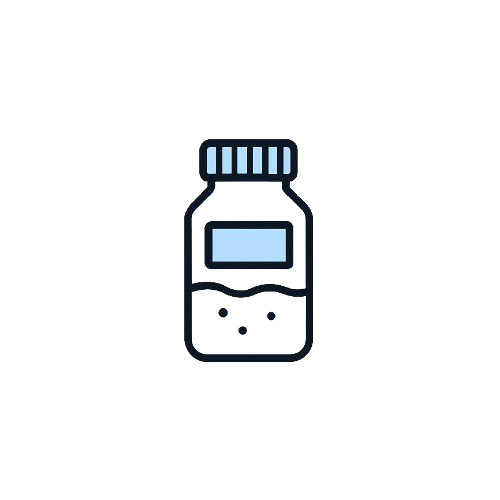Light liquid paraffin
Allopathic
Medicines List
All MedicineIndications
Approved Indications:
- Oral Use (Laxative):
- Short-term relief of constipation, especially in elderly, post-operative, or non-ambulatory patients.
- Management of fecal impaction in certain cases (under medical supervision).
- Topical Use (Dermatological):
- Dry skin conditions including eczema, psoriasis, ichthyosis, and xerosis.
- Pruritus, especially in elderly individuals with aging or flaky skin.
- Cradle cap and nappy rash in infants.
- Soothing and moisturizing treatment for minor burns, radiation dermatitis, and skin irritation.
Clinically Accepted Off-Label Uses:
- Adjunct in managing anal fissures (to reduce trauma during defecation).
- Supportive skin care in patients undergoing chemotherapy or dialysis, where skin dryness is prevalent.
Dosage & Administration
Route of Administration:
- Oral (as laxative)
- Topical (as emollient)
Oral Use
Adults:
- 15–30 mL once daily, preferably at bedtime.
Children over 3 years:
- 5–15 mL once daily, at bedtime (only under medical advice).
Elderly:
- Use with caution. Start at the lowest effective dose to minimize aspiration risk.
Duration:
- Limit use to no more than 7 consecutive days to avoid complications such as lipid pneumonia or vitamin malabsorption.
Administration Notes:
- Take on an empty stomach.
- Avoid taking with meals or before lying down.
- Shake the bottle well before each use.
Topical Use
Adults and Children:
- Apply a thin layer to the affected area 2–3 times daily or as needed.
- Massage gently into the skin until absorbed.
Infants:
- Safe for use on nappy rash and cradle cap. Apply sparingly.
Mechanism of Action (MOA)
- Topical: Light Liquid Paraffin forms an occlusive barrier over the skin, reducing trans-epidermal water loss. This helps retain skin moisture, softens the stratum corneum, and restores the natural lipid barrier, relieving dryness and irritation.
- Oral: Acts as a lubricant laxative by coating the bowel lining and stool surface, reducing water absorption from the stool and facilitating its passage. It does not stimulate bowel motility.
Pharmacokinetics
Topical Use:
- Absorption: Negligible through intact skin.
- Onset: Immediate moisturizing effect upon application.
- Systemic exposure: Minimal to none.
Oral Use:
- Absorption: Poorly absorbed from the gastrointestinal tract.
- Distribution: Minimal systemic distribution.
- Metabolism: Not metabolized.
- Excretion: Eliminated unchanged in feces.
- Onset of Action: Typically 6 to 8 hours after ingestion.
- Bioavailability: Not systemically bioavailable.
Pregnancy Category & Lactation
Pregnancy:
- Topical use: Safe throughout all trimesters.
- Oral use: Not recommended, especially in the third trimester, due to the risk of maternal aspiration and impaired absorption of fat-soluble vitamins.
Lactation:
- Topical use: Considered safe during breastfeeding.
- Oral use: Use with caution; may cause loose stools in breastfed infants if absorbed in significant amounts.
Recommendation:
Topical application is safe in both pregnancy and lactation. Oral use should be avoided unless absolutely necessary and supervised by a physician.
Therapeutic Class
- Primary Class:
- Topical Emollient and Skin Protectant
- Oral Lubricant Laxative
- Subclass:
- Mineral oil derivative
- Non-stimulant laxative
Contraindications
- Hypersensitivity to paraffin or any excipients.
- Intestinal obstruction, appendicitis, or undiagnosed abdominal pain (oral use).
- Dysphagia or aspiration risk (oral use).
- Rectal bleeding or lack of bowel movement after use (oral use).
- Use in infants under 3 years (oral use).
Warnings & Precautions
- Aspiration Risk (oral): May cause lipoid pneumonia, especially in elderly, debilitated, or sedated patients.
- Nutrient Malabsorption: Long-term use may impair absorption of fat-soluble vitamins (A, D, E, K).
- Anal seepage: May occur due to leakage of paraffin oil.
- Fire Hazard (topical): Highly flammable—avoid smoking or open flames after application and around treated fabrics.
- Folliculitis or acne-like eruptions can occur with overuse, especially in oily skin.
- Use cautiously in children and elderly patients.
Side Effects
Topical Use:
- Common:
- Mild skin irritation
- Greasiness
- Uncommon:
- Contact dermatitis
- Folliculitis
- Rare:
- Acneiform eruptions
- Allergic reactions
Oral Use:
- Common:
- Diarrhea
- Anal leakage or discomfort
- Rare:
- Lipoid pneumonia (aspiration)
- Fat-soluble vitamin deficiency (with prolonged use)
Timing & Severity:
Topical side effects are generally mild and local. Oral adverse effects are more severe when misused or used long-term.
Drug Interactions
Oral Use:
- May impair absorption of:
- Fat-soluble vitamins (A, D, E, K)
- Oral contraceptives
- Anticoagulants (e.g., warfarin)
- Avoid co-administration with bulk-forming laxatives or other stool softeners.
Topical Use:
- No known significant drug interactions.
- May affect percutaneous absorption of concurrently applied topical drugs.
CYP450 involvement: Not applicable due to negligible systemic absorption.
Recent Updates or Guidelines
- MHRA and NHS have issued fire safety warnings due to paraffin build-up in clothing and bedding, emphasizing the need to avoid open flames and washing fabrics regularly.
- Recent dermatology guidelines continue to recommend paraffin-based emollients as first-line for eczema and other dry skin disorders.
- Clinical use of oral paraffin is increasingly restricted to short-term use only, due to aspiration risk.
Storage Conditions
- Store between 15°C to 25°C (59°F to 77°F)
- Protect from direct sunlight
- Do not freeze
- Keep tightly closed and in original container
- Keep away from fire or open flames
- For topical products, clean nozzle and cap after each use
- Keep out of reach of children
